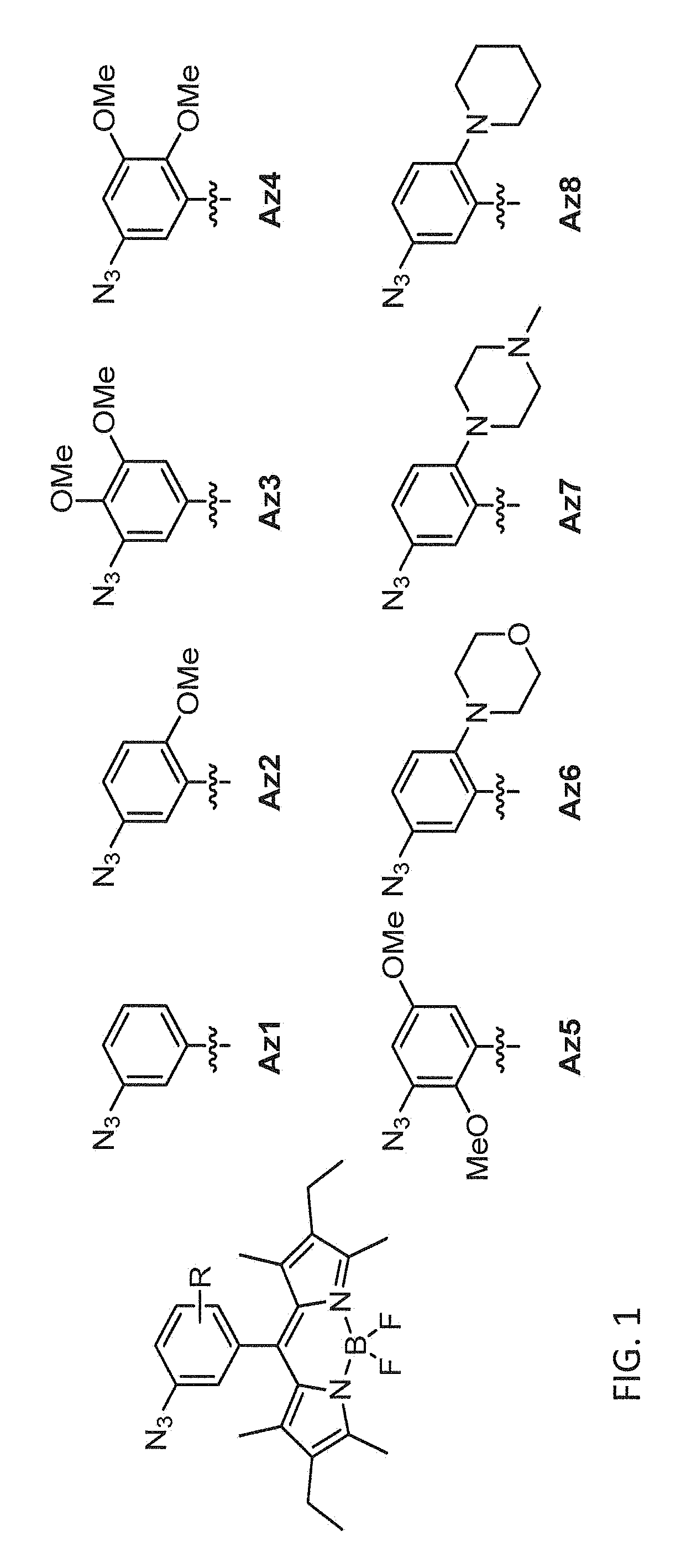Reactive labelling compounds and uses thereof
a technology of reactive labeling and compounds, applied in the field of reactive labeling compounds, can solve the problems of difficult to remove the background fluorescent noise from intracellular environments or tissues, difficult to achieve the effect of enhancing fluorescence, and difficult to fa
- Summary
- Abstract
- Description
- Claims
- Application Information
AI Technical Summary
Benefits of technology
Problems solved by technology
Method used
Image
Examples
example 1
Synthesis of Azido-BODIPY Compounds
Materials
[0236]All the reagents were commercially available and used without further purification unless indicated otherwise. All solvents were anhydrous grade unless indicated otherwise. All non-aqueous reactions were carried out in oven-dried glassware under a slightly positive pressure of argon unless otherwise noted. Reactions were magnetically stirred and monitored by thin-layer chromatography on silica gel. Column chromatography was performed on silica gel of 40-63 μm particle size. Yields are reported for spectroscopically pure compounds.
Instruments
[0237]Melting points were recorded on an Electrothermal MEL-TEMP® 1101D melting point apparatus and were not corrected. NMR spectra were recorded on Bruker AVANCE 600 spectrometer (600 MHz). Chemical shifts are given in δ values relative to tetramethylsilane (TMS); coupling constants J are given in Hz. Internal standards were CDCl3 (δH=7.24) for 1H-NMR spectra, CDCl3 (δc=77.0) for 13C-NMR spectra....
example 2
Synthesis of Triazolyl-BODIPY Compounds
[0248]A convenient route for the synthesis of triazolyl-BODIPY compounds T2, T9, T10 and T11 is disclosed herein. The structure of triazolyl-BODIPY compounds T2, T9, T10 and T11 is shown in FIG. 3. Reagents and step in the synthetic route is as follows.
[0249]The triazolyl-BODIPY compounds T2, T9, T10 and T11 were obtained in reasonable yields by 1,3-dipolar cycloaddition of the azido-BODIPY compounds Az2, Az9, Az10 and Az11 with 4-pentyn-1-ol in CuAAC conditions containing CuSO4, sodium ascorbate and a tris-triazole ligand prepared from tripropargylamine and ethyl azidoacetate. (Zhou, Z.; Fahrni, C. J. Am. Chem. Soc. 2004, 126, 8862-8863).
[0250]
General Synthetic Procedures and Product Characterization of Nitro-BODIPYs
[0251]Substituted nitrobenzaldehyde (3 mmol) and 3-substituted 2,4-dimethylpyrrole (6 mmol) were dissolved in anhydrous CH2Cl2 (400 mL) under an Ar atmosphere. TFA (1 drop) was added, and the resulting solution was stirred at room ...
example 3
Detecting and Imaging Biomolecules
Spectroscopic Measurements
[0308]All spectroscopic measurements of the amino-BODIPY Am10, the azido-BODIPYs Az2 and Az9-Az11 as well as the corresponding triazolyl-BODIPYs T2 and T9-T11 were performed in ethanol using a cuvette with 1-cm path length at 25±0.1° C. All solutions were degassed under argon for several minutes prior to measurements. For each experiment, the slit width was 2.0 nm for both excitation and emission. The absorbance spectra were measured within an absorbance range of 0.07 to 0.7 (l=10 cm). Fluorescence quantum yield measurements were performed on a fluorometer and UV-Vis instrument. Relative quantum efficiencies were obtained by comparing the areas under corrected emission spectrum. The reported quantum yield was calculated as an average of 4 points according to the following equation:
Φsample=Φstandard(Astandard / Asample)(Fsample / Fstandard)(nsample / nstandard)2
where “Φ” is the quantum yield, “A” is the absorbance at the excitati...
PUM
| Property | Measurement | Unit |
|---|---|---|
| excitation/emission wavelengths | aaaaa | aaaaa |
| particle size | aaaaa | aaaaa |
| slit width | aaaaa | aaaaa |
Abstract
Description
Claims
Application Information
 Login to View More
Login to View More - R&D
- Intellectual Property
- Life Sciences
- Materials
- Tech Scout
- Unparalleled Data Quality
- Higher Quality Content
- 60% Fewer Hallucinations
Browse by: Latest US Patents, China's latest patents, Technical Efficacy Thesaurus, Application Domain, Technology Topic, Popular Technical Reports.
© 2025 PatSnap. All rights reserved.Legal|Privacy policy|Modern Slavery Act Transparency Statement|Sitemap|About US| Contact US: help@patsnap.com



